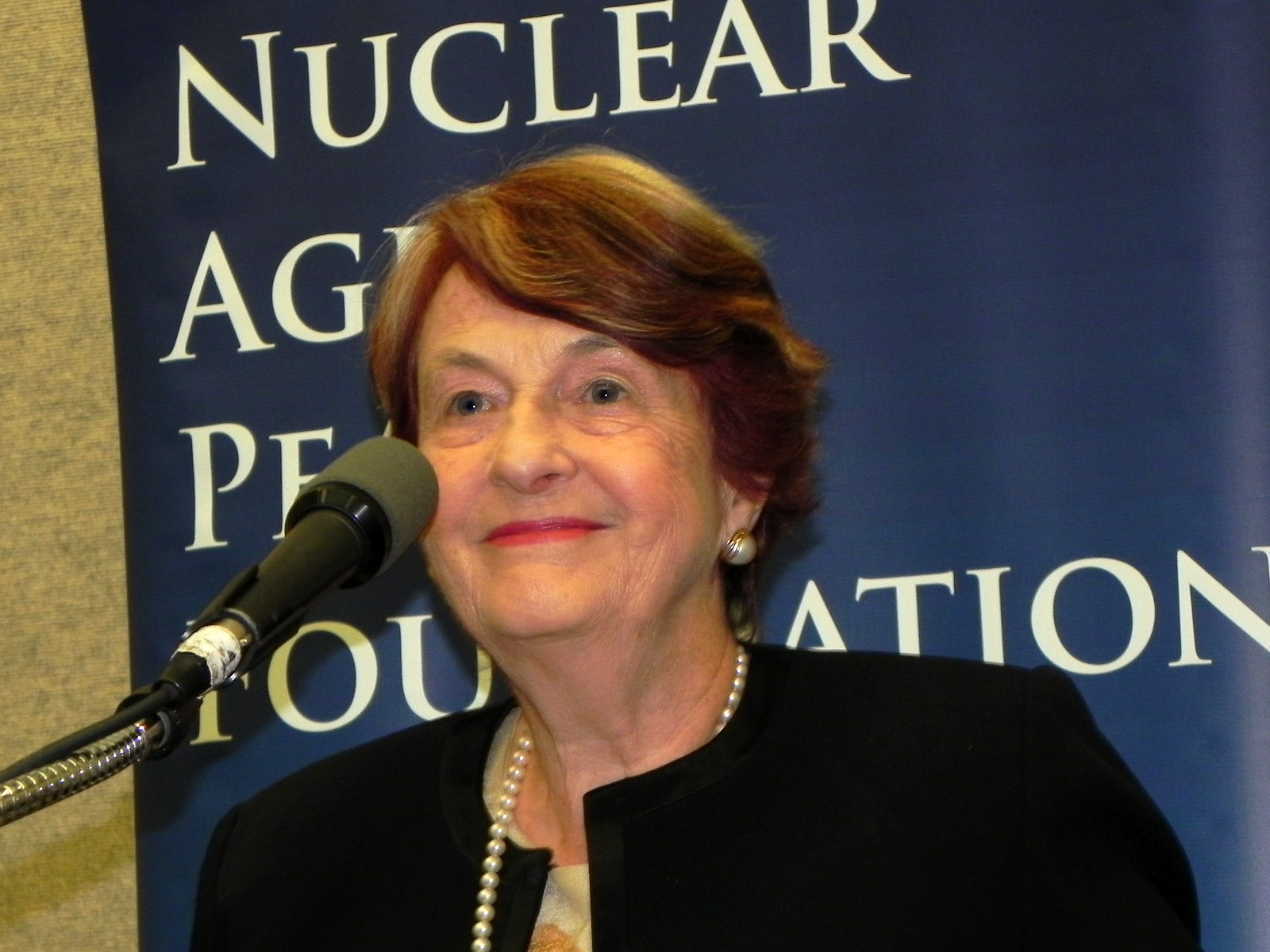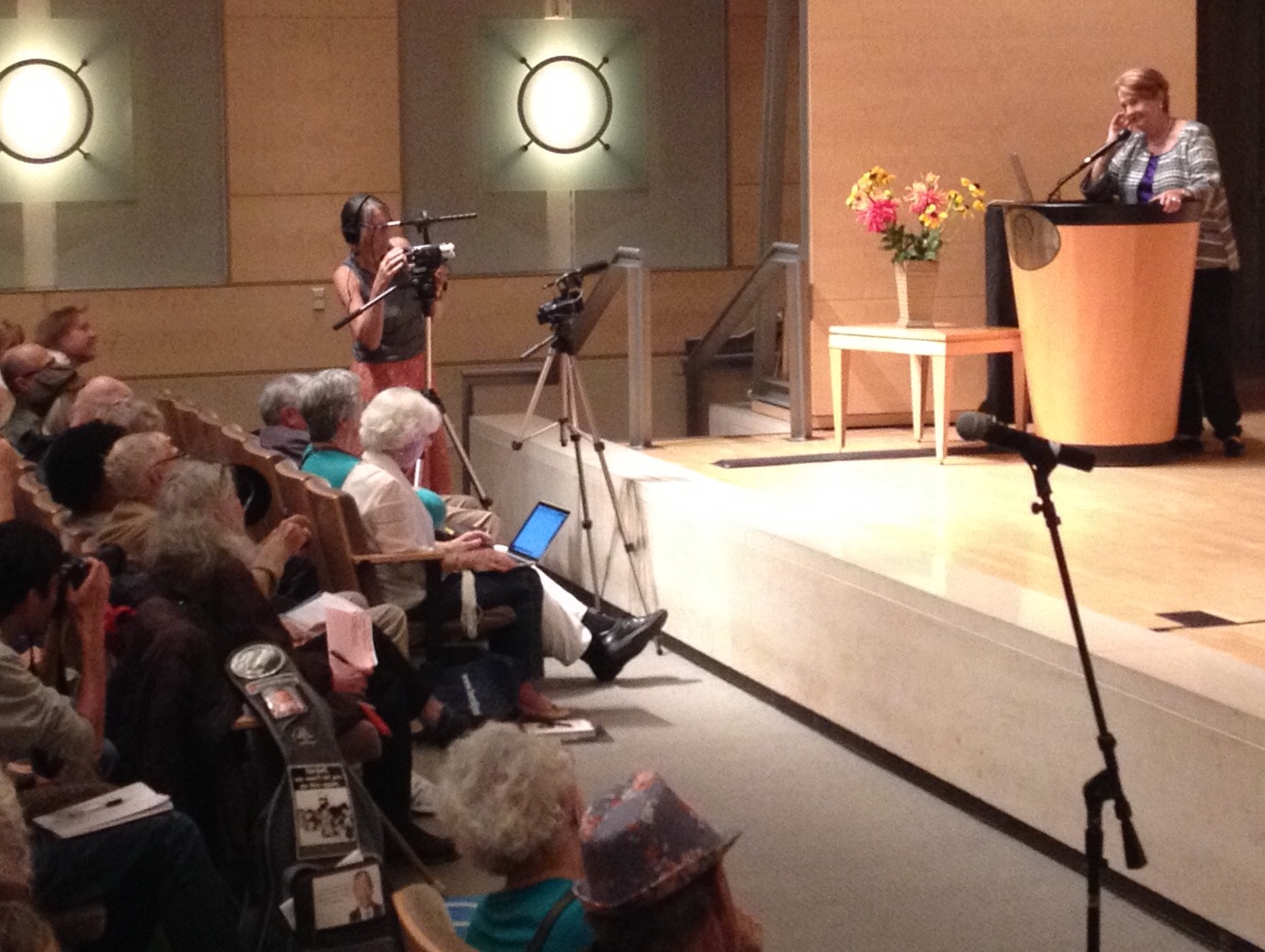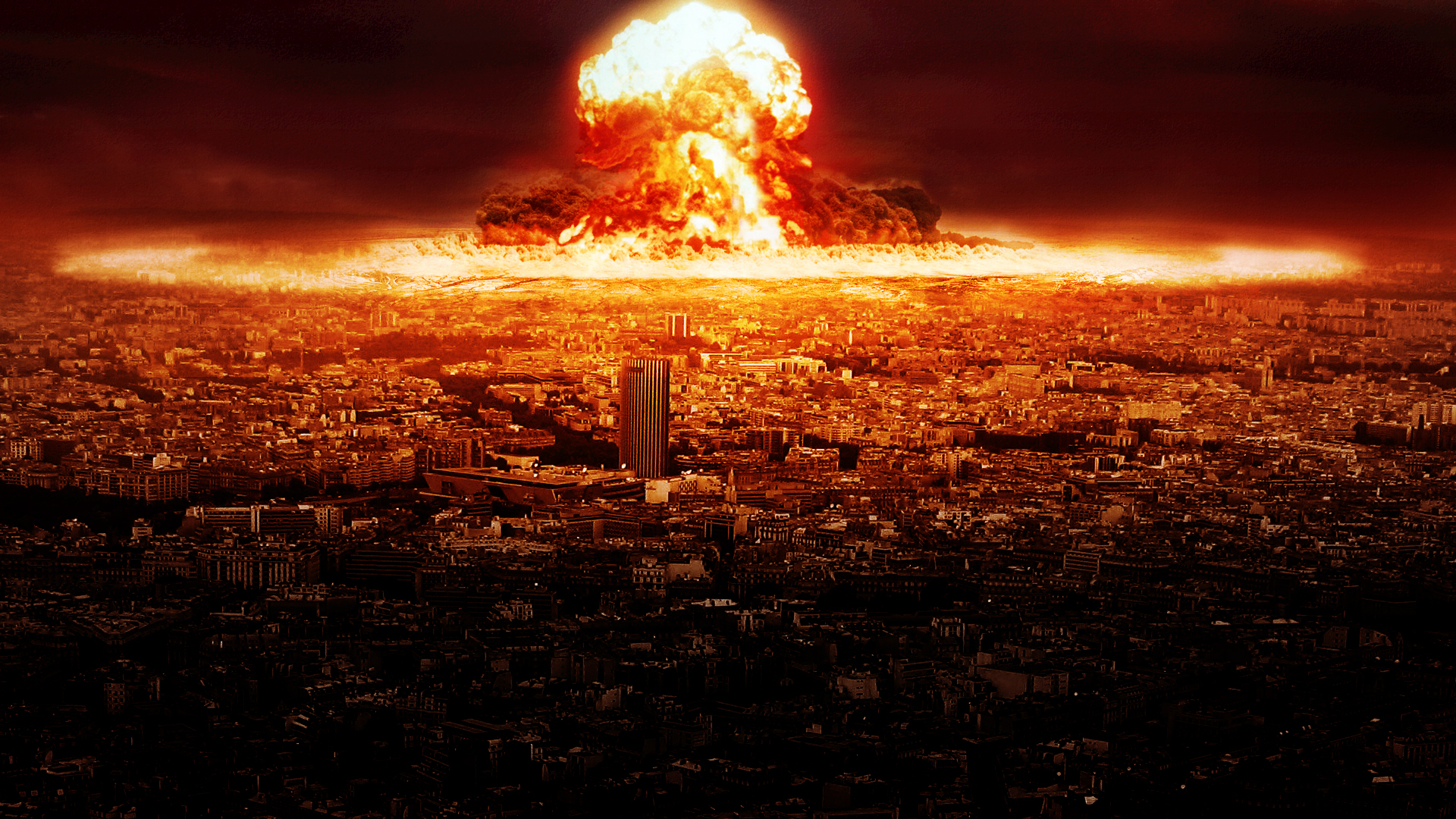 Dr. Caldicott in SF lecture &
interview:
Dr. Caldicott in SF lecture &
interview:
Russia & U.S.A. terrorize the
world,
must
agree to abolish nuclear bombs
WALL news & commentary

![]() “Who are the
real terrorists in the world? Russia and America,” said Helen Caldicott,
Australian medical doctor and the leading activist against nuclear weapons.
“Who are the
real terrorists in the world? Russia and America,” said Helen Caldicott,
Australian medical doctor and the leading activist against nuclear weapons.
![]() She
talked of the terror of missiles armed with nearly 15,000 nuclear bombs in the
two countries on hair-trigger alert and ready to fire on each other; war set
off by a deranged leader, human blunder, computer error or hacking, or an
international crisis; infernos from coast to coast; people vaporized into
black, radioactive clouds; an ice age that ends nearly all life on earth.
She
talked of the terror of missiles armed with nearly 15,000 nuclear bombs in the
two countries on hair-trigger alert and ready to fire on each other; war set
off by a deranged leader, human blunder, computer error or hacking, or an
international crisis; infernos from coast to coast; people vaporized into
black, radioactive clouds; an ice age that ends nearly all life on earth.
![]() The
world has come so close to nuclear war so many times, “I don’t know how we’re
still here,” she said in a San Francisco lecture before a packed Koret
Auditorium in the main San Francisco Public Library.
The
world has come so close to nuclear war so many times, “I don’t know how we’re
still here,” she said in a San Francisco lecture before a packed Koret
Auditorium in the main San Francisco Public Library.
![]() During that talk, on August 13, and in a broadcast on KGO-radio one week
earlier, Dr. Caldicott pleaded for the abolition of nuclear weapons, as she had
been doing for 45 years.
During that talk, on August 13, and in a broadcast on KGO-radio one week
earlier, Dr. Caldicott pleaded for the abolition of nuclear weapons, as she had
been doing for 45 years.
![]() She
wants the people of the U.S. and Russia to insist that their leaders reach a
bilateral agreement to get rid of all their nuclear bombs — most of the world’s
supply. Only then will other nuclear nations do so, she says.
She
wants the people of the U.S. and Russia to insist that their leaders reach a
bilateral agreement to get rid of all their nuclear bombs — most of the world’s
supply. Only then will other nuclear nations do so, she says.
![]() The
meeting was cosponsored by the San Francisco Public Library and the budding
Coalition for Nuclear Disarmament, made up of 15 pro-peace groups. Its
objective: getting Article VI of the Nuclear Non-Proliferation Treaty back on
track. The article mandated early negotiation for a treaty to eliminate nuclear
weapons.
The
meeting was cosponsored by the San Francisco Public Library and the budding
Coalition for Nuclear Disarmament, made up of 15 pro-peace groups. Its
objective: getting Article VI of the Nuclear Non-Proliferation Treaty back on
track. The article mandated early negotiation for a treaty to eliminate nuclear
weapons.
![]() One
of the groups is the San Francisco-based War and Law League (WALL), which
initiated the event as its biennial general meeting and organized the
coalition. These are the other 14 groups:
One
of the groups is the San Francisco-based War and Law League (WALL), which
initiated the event as its biennial general meeting and organized the
coalition. These are the other 14 groups:
American Friends Service Committee; Berkeley Fellowship of Unitarian Universalists; Code Pink; Dominican Sisters of Mission San Jose; East Bay Peace Action; Ecumenical Peace Institute/CALC; Mt. Diablo Peace and Justice; Physicians for Social Responsibility, SF Bay Area Chapter; Shomer Shalom Network for Jewish Nonviolence; Tri-Valley Communities Against a Radioactive Environment; Veterans for Peace, Chapter 69; Western States Legal Foundation; Women’s International League for Peace and Freedom, SF and East Bay Chapters; and World Beyond War.
Triggering nuclear war

![]() Caldicott
cited these examples of events or errors that brought the world close to
nuclear war: A solar storm affected magnetic fields and led a satellite to
indicate that Russia had launched atomic bombs on the U.S. An American weather
satellite over Norway had the Russians thinking that the U.S. had launched such
bombs on them. Someone plugged a war-games tape into a Pentagon computer,
giving the illusion of a Russian attack. Then there was the Cuban missile
crisis.
Caldicott
cited these examples of events or errors that brought the world close to
nuclear war: A solar storm affected magnetic fields and led a satellite to
indicate that Russia had launched atomic bombs on the U.S. An American weather
satellite over Norway had the Russians thinking that the U.S. had launched such
bombs on them. Someone plugged a war-games tape into a Pentagon computer,
giving the illusion of a Russian attack. Then there was the Cuban missile
crisis.
![]() “Any
sort of international anxiety could trigger a nuclear war. We’re at a time of
high international tension right now…. Putin’s probably paranoid. Why
not?—being threatened by the United States with missiles right at his border….
Trump’s a nutter, but at least he’s saying we should make friends with Putin.
Of course we should make friends with
Putin.” But she noted that Donald Trump also was reported to have asked, “If we
have nuclear weapons, why don’t we use them?”
“Any
sort of international anxiety could trigger a nuclear war. We’re at a time of
high international tension right now…. Putin’s probably paranoid. Why
not?—being threatened by the United States with missiles right at his border….
Trump’s a nutter, but at least he’s saying we should make friends with Putin.
Of course we should make friends with
Putin.” But she noted that Donald Trump also was reported to have asked, “If we
have nuclear weapons, why don’t we use them?”
(Making use of our most monstrous weapons against both military and civilian targets, notwithstanding international law to the contrary, seems to have been U.S. policy since the presidency of Harry Truman — editor.)
![]() “America’s official policy now is to start and win a nuclear war. It
hasn’t changed, even under Obama, who is spineless,” Caldicott commented. “If
he were like FDR, he would have inspired the Americans … and said to the
Pentagon, ‘No!’ ”
“America’s official policy now is to start and win a nuclear war. It
hasn’t changed, even under Obama, who is spineless,” Caldicott commented. “If
he were like FDR, he would have inspired the Americans … and said to the
Pentagon, ‘No!’ ”
|
![]() Statistics and images: We will get at
most five minutes’ notice. Each bomb arrives at 20 times the speed of sound, so
you won’t hear it. It will explode with 10 or 20 times the heat inside the center
of the Sun. It will dig a hole three-fourths of a mile wide and 800 feet deep,
and all of us in the buildings and the earth below are ejected into the
mushroom cloud into the stratosphere, out to about five miles.
Statistics and images: We will get at
most five minutes’ notice. Each bomb arrives at 20 times the speed of sound, so
you won’t hear it. It will explode with 10 or 20 times the heat inside the center
of the Sun. It will dig a hole three-fourths of a mile wide and 800 feet deep,
and all of us in the buildings and the earth below are ejected into the
mushroom cloud into the stratosphere, out to about five miles.
![]() In
Hiroshima, a woman had been running with a baby. She was converted into a
charcoal statue. People were walking with skin falling off their bodies, eyes
melted; they looked at the bombs. Winds of 500 miles an hour sucked people out
of buildings. Pieces of glass traveling
at 100 miles an hour decapitated people.
In
Hiroshima, a woman had been running with a baby. She was converted into a
charcoal statue. People were walking with skin falling off their bodies, eyes
melted; they looked at the bombs. Winds of 500 miles an hour sucked people out
of buildings. Pieces of glass traveling
at 100 miles an hour decapitated people.
![]() The
Russian bombs are big, many times bigger than those dropped on Hiroshima and
Nagasaki. Every town in the U.S. of 50,000 population or more is targeted. The
whole San Francisco Bay Area would burn, and so would the entire country, coast
to coast, north to south.
The
Russian bombs are big, many times bigger than those dropped on Hiroshima and
Nagasaki. Every town in the U.S. of 50,000 population or more is targeted. The
whole San Francisco Bay Area would burn, and so would the entire country, coast
to coast, north to south.
![]() Dr.
Caldicott came to the U.S. in 1978, when “Better dead than Red” was a popular
slogan. She organized 23,000 doctors in Physicians for Social Responsibility,
and in the five years that she served as its president, “We educated 80 percent
of Americans to be opposed to the nuclear war concept. We had a million people
in Central Park [in New York City], the biggest rally ever.”
Dr.
Caldicott came to the U.S. in 1978, when “Better dead than Red” was a popular
slogan. She organized 23,000 doctors in Physicians for Social Responsibility,
and in the five years that she served as its president, “We educated 80 percent
of Americans to be opposed to the nuclear war concept. We had a million people
in Central Park [in New York City], the biggest rally ever.”
![]() “Every
morning,” she urged each of her listeners, “decide what you’re going to do
today to save the planet.”
“Every
morning,” she urged each of her listeners, “decide what you’re going to do
today to save the planet.”
On radio:
How Caldicott influenced Reagan to talk peace
with Soviets and agree to scrap atomic bombs
![]() “A short time
ago, an American airplane dropped one bomb on Hiroshima and destroyed its
usefulness to the enemy. That bomb has more power than 20,000 tons of TNT.”
“A short time
ago, an American airplane dropped one bomb on Hiroshima and destroyed its
usefulness to the enemy. That bomb has more power than 20,000 tons of TNT.”
![]() Seventy-one
years after President Harry Truman made that announcement — ignoring the
hundreds of thousands of children, women, and civilian men whose lives his bomb
destroyed — Dr. Helen Caldicott appeared on KGO-radio in San Francisco to plead
for nuclear peace.
Seventy-one
years after President Harry Truman made that announcement — ignoring the
hundreds of thousands of children, women, and civilian men whose lives his bomb
destroyed — Dr. Helen Caldicott appeared on KGO-radio in San Francisco to plead
for nuclear peace.
![]() John
Rothmann’s first question in a half-hour interview was what it was like to meet
with President Reagan. Dr. Caldicott had met the
President’s pro-peace daughter, Patti Davis, who said, “I
think you might be the person who can change my father’s mind” (as quoted by
Rothmann). Patti sat quietly as Reagan and Caldicott talked for an hour and a
quarter (said Caldicott ).
John
Rothmann’s first question in a half-hour interview was what it was like to meet
with President Reagan. Dr. Caldicott had met the
President’s pro-peace daughter, Patti Davis, who said, “I
think you might be the person who can change my father’s mind” (as quoted by
Rothmann). Patti sat quietly as Reagan and Caldicott talked for an hour and a
quarter (said Caldicott ).
![]() Caldicott
quoted Reagan as saying, early in their meeting, “I too am scared of nuclear
war, but … I believe in building more bombs.” Caldicott had just written the
book Missile Envy and was full of
facts and figures.
Caldicott
quoted Reagan as saying, early in their meeting, “I too am scared of nuclear
war, but … I believe in building more bombs.” Caldicott had just written the
book Missile Envy and was full of
facts and figures.
![]() “Almost
every single thing he said to me was wrong or inaccurate, so I would interrupt
him and correct him…. I held his hand about half the time to reassure him…. I
came out saying he had impending Alzheimer’s, and that was the correct
diagnosis.
“Almost
every single thing he said to me was wrong or inaccurate, so I would interrupt
him and correct him…. I held his hand about half the time to reassure him…. I
came out saying he had impending Alzheimer’s, and that was the correct
diagnosis.
![]() “I
thought I’d made no difference to him, but shortly after I’d spent the time
with him, he started to say, ‘Nuclear war must never be fought and can never be
won.’ And that was partly because of the work of Physicians for Social
Responsibility.”
“I
thought I’d made no difference to him, but shortly after I’d spent the time
with him, he started to say, ‘Nuclear war must never be fought and can never be
won.’ And that was partly because of the work of Physicians for Social
Responsibility.”
![]() The group, which
Caldicott activated as president, was presenting televised symposiums in various U.S. cities, showing the effects
of nuclear war. “Clearly he’d seen that, and he started to change…. Gorbachev
saw it as well. We were on Soviet television.”
The group, which
Caldicott activated as president, was presenting televised symposiums in various U.S. cities, showing the effects
of nuclear war. “Clearly he’d seen that, and he started to change…. Gorbachev
saw it as well. We were on Soviet television.”
Meeting in Reykjavik, Iceland, “Reagan and Gorbachev agreed — and it was the most amazing situation — to abolish nuclear weapons bilaterally. But then Reagan got stuck up on Star Wars, which Gorbachev knew would never work. But Reagan was obstinate, and so was Gorbachev.”
![]() Asked about the
importance of a president, she pointed out that an officer carrying a suitcase walks
behind the president. “It’s called ‘the football,’ and inside the football are
the codes to start a nuclear war. The president has only three minutes to
decide whether to launch…. He’s the one, or she, to decide whether or not to
exterminate life on the planet.”
Asked about the
importance of a president, she pointed out that an officer carrying a suitcase walks
behind the president. “It’s called ‘the football,’ and inside the football are
the codes to start a nuclear war. The president has only three minutes to
decide whether to launch…. He’s the one, or she, to decide whether or not to
exterminate life on the planet.”
![]() The legality of giving
a president the equipment to violate the Constitution — which assigns the
authority to initiate war solely to Congress — did not come up.
The legality of giving
a president the equipment to violate the Constitution — which assigns the
authority to initiate war solely to Congress — did not come up.
Getting rid of the bombs
![]() “Can nuclear weapons be
abolished?” Rothmann asked. “Of course they can,” Caldicott replied. “We built
them. We can abolish them.”
“Can nuclear weapons be
abolished?” Rothmann asked. “Of course they can,” Caldicott replied. “We built
them. We can abolish them.”
![]() The
U.S. and Russia have 93 percent of the world’s 16,000 or more nuclear weapons,
she added, and only those two countries can destroy all creation.
The
U.S. and Russia have 93 percent of the world’s 16,000 or more nuclear weapons,
she added, and only those two countries can destroy all creation.
![]() The
interviewer asked what to do about others who have nuclear weapons or try to
obtain them. Answer: “You have no moral authority as the United States, who
first deployed those dreadful weapons. If you decide to abolish nuclear weapons
bilaterally with Russia, only then will you be able to say to North Korea, to
India, to Pakistan, to Israel, ‘OK, you abolish nuclear weapons too.’ ”
The
interviewer asked what to do about others who have nuclear weapons or try to
obtain them. Answer: “You have no moral authority as the United States, who
first deployed those dreadful weapons. If you decide to abolish nuclear weapons
bilaterally with Russia, only then will you be able to say to North Korea, to
India, to Pakistan, to Israel, ‘OK, you abolish nuclear weapons too.’ ”
![]() But
she pointed out that the U.S. was moving in the opposite direction, having
“decided to spend $1 trillion replacing and rebuilding every single nuclear
missile, hydrogen bomb, submarine, aircraft carrier, and airplane.”
But
she pointed out that the U.S. was moving in the opposite direction, having
“decided to spend $1 trillion replacing and rebuilding every single nuclear
missile, hydrogen bomb, submarine, aircraft carrier, and airplane.”
![]() Rothmann
asked what to do about “rogue nations” and terrorists? She said, “North Korea
could blow up a city. I’m talking about the end of life on earth.
Rothmann
asked what to do about “rogue nations” and terrorists? She said, “North Korea
could blow up a city. I’m talking about the end of life on earth.
![]() “
… A thousand bombs dropping on a hundred cities would create such a huge
firestorm and America would burn from coast to coast, north to south. The
radioactive smoke would rise into the stratosphere, blocking out the sun for up
to ten years, inducing a short ice age where everything and everyone would freeze
to death in the dark….
“
… A thousand bombs dropping on a hundred cities would create such a huge
firestorm and America would burn from coast to coast, north to south. The
radioactive smoke would rise into the stratosphere, blocking out the sun for up
to ten years, inducing a short ice age where everything and everyone would freeze
to death in the dark….
![]() “We
are on the edge of destruction…. There is nothing else, even global warming,
that is as important as this… Nobody in the presidential election has even
talked about this.”
“We
are on the edge of destruction…. There is nothing else, even global warming,
that is as important as this… Nobody in the presidential election has even
talked about this.”
![]() In
the 80s, “we mobilized 80 percent [of the American people] to oppose nuclear
weapons and nuclear war.” She blamed the
current mass media for ignoring what should be the number-one issue.
In
the 80s, “we mobilized 80 percent [of the American people] to oppose nuclear
weapons and nuclear war.” She blamed the
current mass media for ignoring what should be the number-one issue.
![]() Men
like William J. Perry, former secretary of defense, and General James
Cartwright and others say “we’re closer to nuclear war than we were at the
height of the cold war,” Caldicott said.
Men
like William J. Perry, former secretary of defense, and General James
Cartwright and others say “we’re closer to nuclear war than we were at the
height of the cold war,” Caldicott said.
![]() The
launching of nuclear bombs need not be the decision of a rational person. “They
could be launched by hacking, by computer error, by a president developing a
brain tumor or becoming psychotic. We’re in the hands of fallible human
beings.”
The
launching of nuclear bombs need not be the decision of a rational person. “They
could be launched by hacking, by computer error, by a president developing a
brain tumor or becoming psychotic. We’re in the hands of fallible human
beings.”
(For background, see “Nuclear foe Helen Caldicott to speak in SF on disarming as USA enhances its arsenal,” this site, May 25, 2016. See also, “Our two-faced policy on nuclear weapons,” this site, June 29, 2012.)
August 15, 2016
